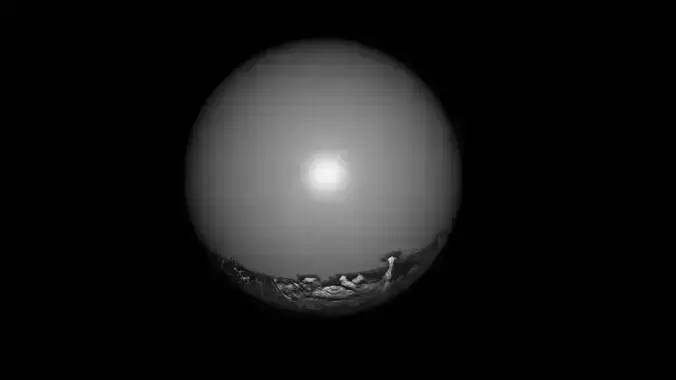1/14
Miranda Planet (also designated Uranus V) is the smallest and innermost of Uranus's five round satellites. It was discovered by Gerard Kuiper on 16 February 1948 at McDonald Observatory in Texas, and named after Miranda from William Shakespeare's play The Tempest. Like the other large moons of Uranus, Miranda orbits close to its planet's equatorial plane. Because Uranus orbits the Sun on its side, Miranda's orbit is nearly perpendicular to the ecliptic and shares Uranus's extreme seasonal cycle. At just 470 km (290 mi) in diameter, Miranda is one of the smallest closely observed objects in the Solar System that might be in hydrostatic equilibrium (spherical under its own gravity), and its total surface area is roughly equal to that of the U.S. state of Texas. The only close-up images of Miranda are from the Voyager 2 probe, which made observations of Miranda during its Uranus flyby in January 1986. During the flyby, Miranda's southern hemisphere pointed towards the Sun, so only that part was studied. Miranda probably formed from an accretion disc that surrounded the planet shortly after its formation and, like other large moons, it is likely differentiated, with an inner core of rock surrounded by a mantle of ice. Miranda has one of the most extreme and varied topographies of any object in the Solar System, including Verona Rupes, a roughly 20-kilometre-high (12 mi) scarp that may be the highest cliff in the Solar System and chevron-shaped tectonic features called coronae. The origin and evolution of this varied geology, the most of any Uranian satellite, are still not fully understood, and multiple hypotheses exist regarding Miranda's evolution. Miranda was discovered on 16 February 1948 by planetary astronomer Gerard Kuiper using the McDonald Observatory's 82-inch (2,080 mm) Otto Struve Telescope. Its motion around Uranus was confirmed on 1 March 1948. It was the first satellite of Uranus discovered in nearly 100 years. Kuiper elected to name the object Miranda after the character in Shakespeare's The Tempest, because the four previously discovered moons of Uranus, Ariel, Umbriel, Titania, and Oberon, had all been named after characters of Shakespeare or Alexander Pope. However, the previous moons had been named specifically after fairies, whereas Miranda was a human. Subsequently discovered satellites of Uranus were named after characters from Shakespeare and Pope, whether fairies or not. The moon is also designated Uranus V. Planetary moons other than Earth's were never given symbols in the astronomical literature. Denis Moskowitz, a software engineer who designed most of the dwarf planet symbols, proposed an M (the initial of Miranda) combined with the low globe of Jérôme Lalande's Uranus symbol as the symbol of Miranda (). This symbol is not widely used. Orbit of Uranus's five round satellites, Miranda orbits closest to it, at roughly 129 000 km from the surface; about a quarter again as far as its most distant ring. It is the round moon that has the smallest orbit around a major planet. Its orbital period is 34 hours and, like that of the Moon, is synchronous with its rotation period, which means it always shows the same face to Uranus, a condition known as tidal locking. Miranda's orbital inclination (4.34°) is unusually high for a body so close to its planet – roughly ten times that of the other major Uranian satellites, and 73 times that of Oberon. The reason for this is still uncertain; there are no mean-motion resonances between the moons that could explain it, leading to the hypothesis that the moons occasionally pass through secondary resonances, which at some point in the past led to Miranda being locked for a time into a 3:1 resonance with Umbriel, before chaotic behaviour induced by the secondary resonances moved it out again. In the Uranian system, due to the planet's lesser degree of oblateness and the larger relative size of its satellites, escape from a mean-motion resonance is much easier than for satellites of Jupiter or Saturn. Miranda's apparent magnitude is +16.6, making it invisible to many amateur telescopes. Virtually all known information regarding its geology and geography was obtained during the flyby of Uranus made by Voyager 2 on 25 January 1986, The closest approach of Voyager 2 to Miranda was 29,000 km (18,000 mi)—significantly less than the distances to all other Uranian moons. Of all the Uranian satellites, Miranda had the most visible surface. The discovery team had expected Miranda to resemble Mimas, and found themselves at a loss to explain the moon's unique geography in the 24-hour window before releasing the images to the press. In 2017, as part of its Planetary Science Decadal Survey, NASA evaluated the possibility of an orbiter to return to Uranus some time in the 2020s. Uranus was the preferred destination over Neptune due to favourable planetary alignments meaning shorter flight times.
Texture Resolution: 1266 x 632
REVIEWS & COMMENTS
accuracy, and usability.














